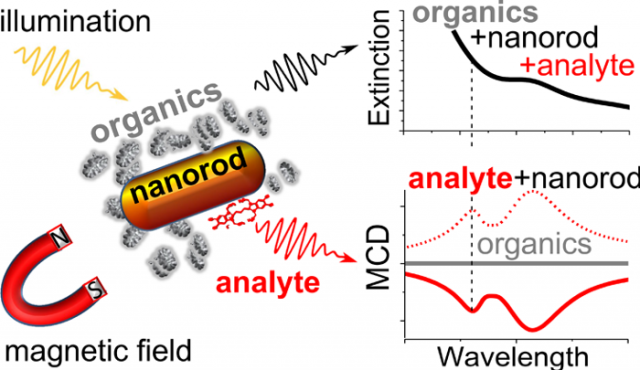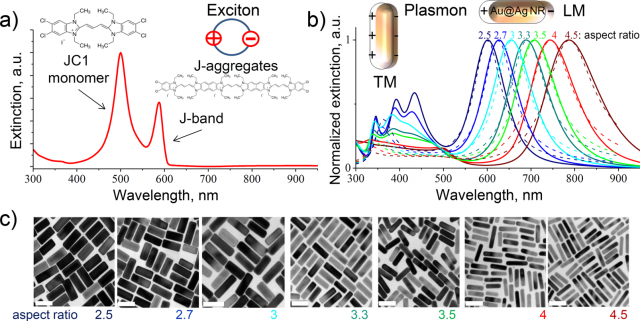Magneto-optical activity of a nonmagnetic organic compound

We know that incident light can provoke a strong optical response in metallic nanostructures due to the excitation of resonant plasmonic modes, i.e, the electrons in the metal become excited by the photons in the incident light and oscillate collectively.
Plasmonic nanoparticles can significantly modify the optical properties of nearby organic molecules and thus present an attractive opportunity for sensing applications. However, the utilization of plasmonic nanoparticles in conventional absorption, fluorescence, or Raman spectroscopy techniques is often ineffective due to the strong absorption background and light being scattered, particularly in the case of turbid solutions, cell suspensions, and biological tissues.
This problem, if solved – that is, if there were a way of using plasmonic nanoparticles intrinsically insensitive to the organic background -, would offer a significant advantage over conventional spectroscopy techniques for chemo- and biosensing.
A team of researchers, including Ikerbasque professors and DIPC’s and CFM’s Yury P. Rakovich, now demonstrates 1 that the magneto-optical activity of an organic compound can be greatly enhanced by coupling to a resonant plasmonic nanoparticle, leading to the formation of a hybrid state in which new magnetic properties emerge.

A J-aggregate is a type of organic dye with an absorption band that shifts to a longer wavelength of increasing sharpness (higher absorption coefficient) when it aggregates under the influence of a solvent or additive or concentration as a result of supramolecular self-organisation.
The researchers show that nonmagnetic organic molecules may exhibit magneto-optical response due to binding to a plasmonic nanoparticle using supramolecular J-aggregates bonded to silver-coated gold nanorods. In the experiments the magneto-optical detection was possible at room temperature and using weak magnetic fields (<1 T).
The formation of coupled hybrid systems, where specific molecules are coupled to plasmonic nanostructures and acquire magnetic properties, paves the way toward the development of novel magnetic methods for sensing, which are intrinsically insensitive to the (organics) scattering background. Moreover, the features of this magneto-optical activity indicate that it could be used for the fundamental investigation of properties of hybrid organic/inorganic systems in the strong coupling regime.
The researchers envision a great impact of this work onto biological research, pharmacology, materials science, and organic semiconductor industry with applications in sensing and biosensing, optical magnetic data storage, communications systems, and quantum computing.
Author: César Tomé López is a science writer and the editor of Mapping Ignorance.
References
- Dzmitry Melnikau, Alexander A. Govyadinov, Ana Sánchez-Iglesias, Marek Grzelczak, Luis M. Liz-Marzán, and Yury P. Rakovich (2017) Strong Magneto-Optical Response of Nonmagnetic Organic Materials Coupled to Plasmonic Nanostructures Nano Letters DOI: 10.1021/acs.nanolett.6b05128 ↩